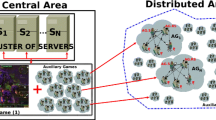Abstract
With the recent explosion in deployment of services to large numbers of customers over the Internet and in global services in general, issues related to the architecture of scalable servers are becoming increasingly important. However, our understanding of these types of applications is currently limited, especially on how well they scale to support large numbers of users. One such, novel, commercial class of applications, are interactive, multi-player game servers. Multi-player games are both an important class of commercial applications (in the entertainment industry) and they can be valuable in understanding the architectural requirements of scalable services. They impose requirements on system performance, scalability, and availability, stressing multiple aspects of the system architecture (e.g., compute cycles and network I/O). Recently there has been a lot of interest on client side issues with respect to games. However, there has beenlittle or no work on the server side. In this paper we use a commercial game server to gain insight in this class of applications and the requirements they impose on modern architectures. We find that: (1) In terms of the benchmarking methodology, interactive game servers are very different from scientific workloads. We propose a methodology that deals with the related issues in benchmarking this class of applications. Our methodology bears many similarities with methodologies used in benchmarking online transaction processing (OLTP) systems. (2) Current, sequential game servers can support at most up to a few tens of users (60–100) on existing processors. (3) The bottleneck in the server is both game-related as well as network-related processing (about 50–50). (4) Network bandwidth requirements are not an important issue for the numbers of players we are interested in. (5) The processor achieves a surprisingly low IPC of 0.416.
Similar content being viewed by others
References
A. Ailamaki, D.J. DeWitt, M.D. Hill and D.A. Wood, DBMSs on a modern processor: Where does time go?, in: Proc. of the 25th Int. Conference on Very Large Databases (September 1999) pp. 266-277.
L.A. Barroso, K. Gharachorloo and E. Bugnion, Memory system characterization of commercial workloads, in: ISCA (1998) pp. 3-14.
A. Bilas, J. Fritts and J.P. Singh, Real time parallel MPEG-2 decoding in software, in: Proc. of the 11th International Parallel Processing Symposium (IPPS97) (April 1997).
J. Fritts, W. Wolf and B. Liu, Understanding multimedia application characteristics for designing programmable media processors, in: SPIE Photonics West, Media Processors'99, San Jose, CA (January 1999) pp. 2-13.
id Software, id Software Home Page, http://www.idsoftware.com
id Software, Quake Home Page, http://www.idsoftware.com/quake
Intel Corp., EMON, http://www.intel.com
K. Keeton and D. Patterson, Towards a simplified database workload for computer architecture evaluations, in: Workload Characterization for Computer System Design, eds. L.K. John and A.A. Maynard (Kluwer Academic, 2000).
A.M.G. Maynard, C.M. Donnelly and B.R. Olszewski, Contrasting characteristics and cache performance of technical and multiuser commercial workloads, in: Proc. of the 6th International Conference on Architectural Support for Programming Languages and Operating Systems (ASPLOS6) (October 1994) pp. 145-156.
P. Ranganathan, S.V. Adve and N.P. Jouppi, Performance of image and video processing with general-purpose processors and media ISA extensions, in: Proc. of the 26th Annual Int. Symposium on Computer Architecture (ISCA'99) (1999) pp. 124-135.
P. Ranganathan, K. Gharachorloo, S.V. Adve and L.A. Barroso, Performance of database workloads on shared-memory systems with outof-order processors, in: Proc. of the 8th International Conference on Architectural Support for Programming Languages and Operating Systems (ASPLOS8) (1998) pp. 307-318.
P. Trancoso, J.-L. Larriba-Pey, Z. Zhang and J. Torrellas, The memory performance of DSS commercial workloads in shared-memory multiprocessors, in: Proc. of the 3nd IEEE Symposium on High-Performance Computer Architecture (HPCA3) (1997).
Transaction Processing Performance Council, Transaction Processing Performance Council Home Page, http://www.tpc.org
Z. Zhang and S. Sarukkai, Commercial applications on shared-memory multiprocessors, in: Proc. of the 1st Workshop on Computer Architecture Evaluation Using Commercial Workloads (February 1998).
Author information
Authors and Affiliations
Rights and permissions
About this article
Cite this article
Abdelkhalek, A., Bilas, A. & Moshovos, A. Behavior and Performance of Interactive Multi-Player Game Servers. Cluster Computing 6, 355–366 (2003). https://doi.org/10.1023/A:1025718026938
Issue Date:
DOI: https://doi.org/10.1023/A:1025718026938




